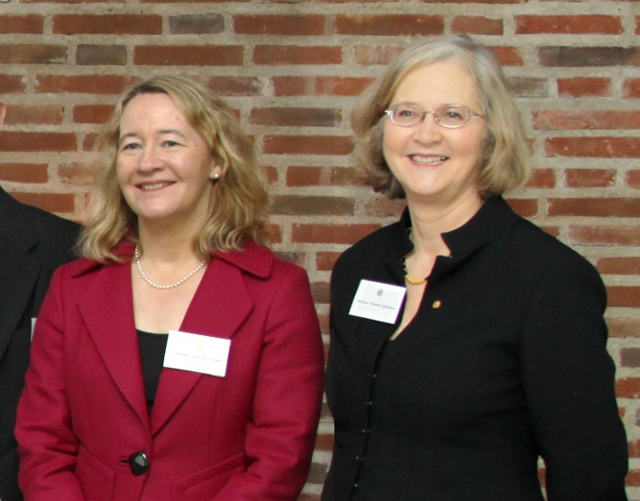
This week’s countdown to Ada Lovelace Day (two weeks to go!) continues with a dual biosketch on Professors Elizabeth Blackburn and Carol Greider, co-winners of the 2009 Nobel Prize for Physiology or Medicine for their work on telomeres. Read on!
***
Elizabeth Blackburn was born in Tasmania in 1948, the daughter of two physicians with a family practice in Hobart. About the time she was thirteen — still living in Tasmania with a menagerie of animals and playing piano — Carol Greider was born in San Diego, California. I myself don’t care much for the idea of fate, but it’s interesting to see the paths both took to the same lab at the University of California, where, in the 1980s, they would perform work that would later win them the Nobel Prize.
Blackburn, needless to say, had more physical ground to cover. Starting with a move to Melbourne for high school, she stuck around that city until she had received both a B.S. and M.S. from the University of Melbourne. After that, she moved to Cambridge in the UK, where she worked on the Phi X 174 bacteriophage (the first DNA-based genome ever to be synthesized), receiving her doctorate in 1974. After that it was on to Yale for a postdoc before taking a position at UC Berkley, in 1981.
Greider, born in 1961, was the daughter of two doctors as well — one of physics and the other of botany — who grew up in Davis, California. While she didn’t end up as physically far from where she started as Blackburn, she did have some ways to go herself. Aside from the family moving to Germany when she was ten, which is a far enough distance, she also writes in her biographical note on the Nobel Prize page that, as a child, she had “thought of [her]self as “stupid” because [she] needed remedial help.” Much later it turned out that Greider was dyslexic, which she later credited with giving her the ability to think around her own limitations.
Greider received her B.A. in biology from UC Santa Barbara in 1983, and then joined Elizabeth Blackburn’s lab at UC Berkley, where, as a doctoral student, she worked with her supervisor on the discovery that would (after the scientific world had taken some years to realize the value of their work) merit them the Nobel Prize.
Blackburn and Greider shared the 2009 Nobel Prize for Physiology or Medicine with Jack Szostak for the discovery of the enzyme telomerase and its role in lengthening telomeres. Let me back up and just explain what that means.
At the end of your (and basically all eukaryotic) cells’ DNA are these repeating sequences called telomeres. When cells replicate, for the most part, they lose a little off that end. This isn’t a bug, it’s a feature. By the time the telomeres have worn away, the chances of random errors in copying taking place are higher — it’s like making a photocopy of a photocopy of a photocopy. The result gets worse each time. The ever-shortening telomere leads eventually to apoptosis, the name we use for cells spontaneously dropping dead, which sounds bad, but is actually really helpful. I’ll explain why in a second.
Blackburn, Greider, and Szostak discovered an enzyme, telomerase, that restores the ground-down bits of telomere, allowing cells to reproduce themselves over and over. This is a helpful process in places like the testes (for instance), where the continued reproduction of sperm is kind of important. But in many other places, the continued repair of telomeres is a problem. What happens when cells don’t stop reproducing when they should? Well, in a word, cancer.
Roughly ninety percent of human cancers have telomerase lengthening their cells’ telomeres so they can reproduce forever. The other ten percent just seem to have another, non-telomerase way of doing the same thing. So before you go around saying “we need to stop our telomeres shortening to solve aging,” just remember that human life is a fine balance between cell death and cancer.
These days, Elizabeth Blackburn is still researching telomeres as the Morris Herzstein Professor of Biology and Physiology at UC San Francisco. Carol Greider is doing similar work as the Daniel Nathans Professor and Director of Molecular Biology and Genetics at Johns Hopkins University. You can find out more about them at their Nobel Prize profile pages.
Elizabeth Blackburn, Nobel Prize for Physiology or Medicine, 2009
Carol Greider, Nobel Prize for Physiology or Medicine, 2009
***
Richard Ford Burley is a doctoral candidate in English at Boston College, where he’s writing about remix culture and the processes that generate texts in the Middle Ages and on the internet. In his spare time he writes about science, skepticism, and feminism (and really, really dumb fictional aliens) here at This Week In Tomorrow.

One thought on “Elizabeth Blackburn and Carol Greider | Vol. 2 / No. 48.2”
Comments are closed.